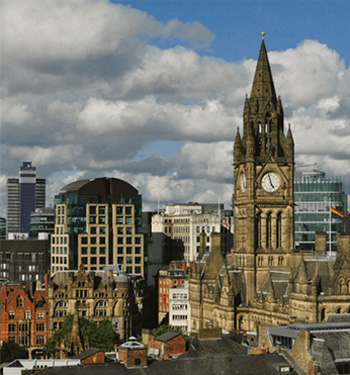High air pollution levels in urban areas can worsen pre-existing health conditions. Greater Manchester residents are increasingly concerned, and are seeking practical, place-based solutions to tackle the issue. Here, Professor Sheena Cruickshank, from The University of Manchester, discusses the Ardwick Climate Action Community road closure, to show how such events can help decrease air pollution levels – and suggests the need to foster more place-based, community-centred solutions to tackle air pollution in England’s cities.
- Road closures can prove successful in reducing air pollution levels.
- Collaborative working between local communities, healthcare workers and researchers is a vital tool to develop new forms of safe active travel.
- Engaging with communities is key to promoting awareness of pollution risks and understanding local sources of pollution and barriers to active travel.
Air pollution in Greater Manchester
Greater Manchester (GM) has amongst the worse levels of pollution in the UK with around 1,200 yearly premature deaths, and pollution monitoring stations frequently recording figures above World Health Organisation (WHO) guidelines. As vehicles are a major contributor to pollution, reducing car use and enhancing active transport is a major GM strategic priority, with initiatives to tackle pollution such as the ‘Greater Manchester’s Clean Air Zone’ and the Bee Network to make active travel the number one choice. Plans to improve pavements and implement cycle lanes have started in some boroughs of GM. However, some areas remain pollution “hot spots”, including Ardwick which is bordered by busy major roads like the A6 and the Mancunian Way.
Why should we take air pollution seriously?
Outdoor air pollution comes from numerous sources, including vehicle exhausts, industrial waste, and the burning of fuels and refuse. The WHO estimates that outdoor air pollution leads to 4.2 million deaths every year, and worsens pre-existing conditions such as allergies and asthma. Similarly, studies have shown that pollution worsens responses and outcomes to respiratory infections such as flu and COVID-19. The health effects of air pollution are unevenly distributed across the population: the elderly, children, and those with pre-existing health conditions are the most vulnerable along with people living in deprived areas (more likely to live next to busy roads and less access to high-quality medical care).
The Ardwick Climate Action Community A6 Closure Event
Research we have conducted with residents in Ardwick and the GMCA revealed multiple barriers to take-up of active travel. Residents are concerned about the impacts of pollution on their health and, particularly, their children’s health. Indeed, analysis of pollution levels near several GM schools including the primary school in Ardwick revealed high levels of pollution.
To highlight this issue, Ardwick Climate Action closed a section of the A6 for a few hours with the local community. They also launched a programme of activity by residents to start planting and nurturing green spaces to try and offset the pollution. The closure was supported by staff and students from The University of Manchester. Some pollution measurements were taken during and after the road closure.
To see if the road closure affected the level of black carbon – a good indicator for combustion related air pollution – we tested the levels on a day that the road was open as usual, to act as a comparison. The results clearly show that there is a decrease in measured levels of black carbon on the day that the road was closed, which then increased as the road opened up again. Whereas, on the day that the road was continuously open, the black carbon levels never decreased and continued to rise as time went on.
The observation indicates that the closure of the A6 had a positive impact on reducing black carbon concentrations in the ambient air surrounding the road. The road was reopened at 11:30AM and monitoring was moved from the centre of the road to Ardwick Green, after which we saw black carbon levels increase. It has been previously shown that, in addition to measures to reduce traffic flow, plants can help reduce the impact of pollution. These results highlight the need for more positive action to address the volume of traffic, as well as enhance provision of green spaces in city centres.
 Ways to move forward across Greater Manchester
Ways to move forward across Greater Manchester
Further analysis, and further measurements, are required to ascertain how we can enhance air quality. As well as increasing planting, we will seek to determine barriers that prevent residents walking in the area. By working with Ardwick residents in the Ardwick Climate Action Group, the GM community, and NHS partners – and using a participatory, active, and creative approach with residents and artists – we will capture local knowledge, amplify residents’ voices, and provide a legacy of maps and way finders for the community to develop community paths and routes to enable safer active travel. Findings will be communicated with Manchester City Council to inform about barriers preventing active travel and feed into the GM active travel network plans and enhance the effectiveness of the long-term Greater Manchester Combined Authority strategy.
Policy recommendations:
- Further analysis, and further measurements, are required to ascertain whether the closure to traffic had a significant effect on air quality.
- Place-based participatory research geared towards the needs of local communities should be favoured and adopted across GM in order to tackle air pollution levels.
- Further links between GMCA and its neighbourhoods should be developed to enhance the effectiveness of the long-term GMCA strategy.
Policy@Manchester aims to impact lives globally, nationally and locally through influencing and challenging policymakers with robust research-informed evidence and ideas.
More Information:
Sign up to our newsletter and keep up to date with our latest news by visiting our website:









